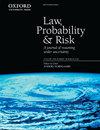用于确定刑事审判准确结果的机器学习
IF 1.4
4区 社会学
Q1 LAW
引用次数: 4
摘要
数学和计算技术的进步为整个社会的各个领域(工程、医学、经济学等)带来了独特和突破性的好处。然而,在法律体系中,数据科学和创新数学工具的潜在应用尚未得到同样的雄心壮志。做出公正判决所需的复杂决策往往被认为是这种方法无法实现的,在刑事审判中,这阻碍了对机器学习是否能产生积极影响的探索。在这里,通过为控方和辩方的证据分配数值分数,并采用基于降维的方法,我们表明,在历史谋杀审判中呈现的证据链可以用来训练有效的机器学习算法(或模型)。我们用训练好的模型测试了证据量化方法,结果表明,通过机器学习,刑事案件可以被清楚地分类(概率>99.9%),分为有罪或无罪类别。发现所有测试用例的分类都是预期的。根据我们的模型,所有没有被错误定罪的有罪测试案例都被正确地分配到有罪类别,关键的是,被错误定罪的测试案例被正确地分配到无罪类别。这项工作证明了机器学习有利于刑事审判决策的潜力,并应激励进一步测试和开发模型和数据集,以协助司法程序。本文章由计算机程序翻译,如有差异,请以英文原文为准。
Machine learning for determining accurate outcomes in criminal trials
Advances in mathematical and computational technologies have brought unique and ground-breaking benefits to diverse fields throughout society (engineering, medicine, economics, etc.). Within legal systems, however, the potential applications of data science and innovative mathematical tools have yet to be embraced with the same ambition. The complex decision-making that is needed for reaching just verdicts is often seen as out of reach for such approaches and, in the case of criminal trials, this inhibits exploration into whether machine learning could have a positive impact. Here, through assigning numerical scores to prosecution and defence evidence, and employing an approach based on dimensionality reduction, we showed that evidence strands presented at historical murder trials could be used to train effective machine-learning algorithms (or models). We tested the evidence quantification approach with the trained model and showed that, through machine learning, criminal cases could be clearly classified (probability >99.9%) as belonging to either a guilty or a not-guilty category. The classification was found to be as expected for all test cases. All guilty test cases that were not wrongful convictions were correctly assigned to the guilty category by our model and, crucially, test cases that were wrongful convictions were correctly assigned to the not-guilty category. This work demonstrated the potential for machine learning to benefit criminal trial decision-making, and should motivate further testing and development of the model and datasets for assisting the judicial process.
求助全文
通过发布文献求助,成功后即可免费获取论文全文。
去求助
来源期刊

Law Probability & Risk
MATHEMATICSSTATISTICS & PROBABILITY&-STATISTICS & PROBABILITY
CiteScore
2.10
自引率
28.60%
发文量
8
期刊介绍:
Law, Probability & Risk is a fully refereed journal which publishes papers dealing with topics on the interface of law and probabilistic reasoning. These are interpreted broadly to include aspects relevant to the interpretation of scientific evidence, the assessment of uncertainty and the assessment of risk. The readership includes academic lawyers, mathematicians, statisticians and social scientists with interests in quantitative reasoning.
The primary objective of the journal is to cover issues in law, which have a scientific element, with an emphasis on statistical and probabilistic issues and the assessment of risk.
Examples of topics which may be covered include communications law, computers and the law, environmental law, law and medicine, regulatory law for science and technology, identification problems (such as DNA but including other materials), sampling issues (drugs, computer pornography, fraud), offender profiling, credit scoring, risk assessment, the role of statistics and probability in drafting legislation, the assessment of competing theories of evidence (possibly with a view to forming an optimal combination of them). In addition, a whole new area is emerging in the application of computers to medicine and other safety-critical areas. New legislation is required to define the responsibility of computer experts who develop software for tackling these safety-critical problems.
 求助内容:
求助内容: 应助结果提醒方式:
应助结果提醒方式:


